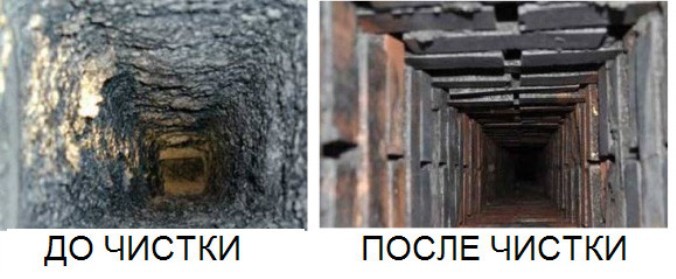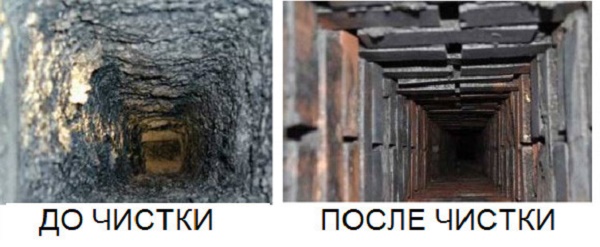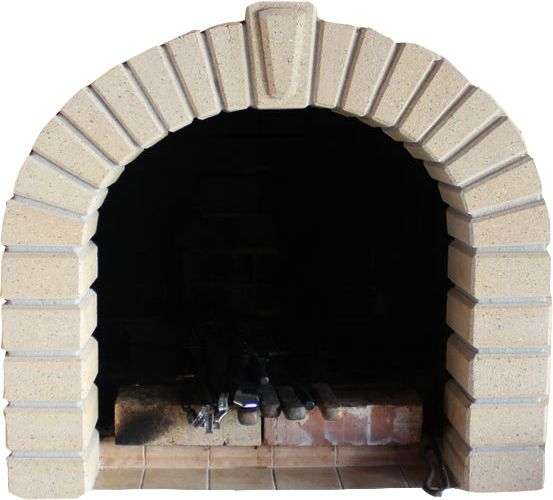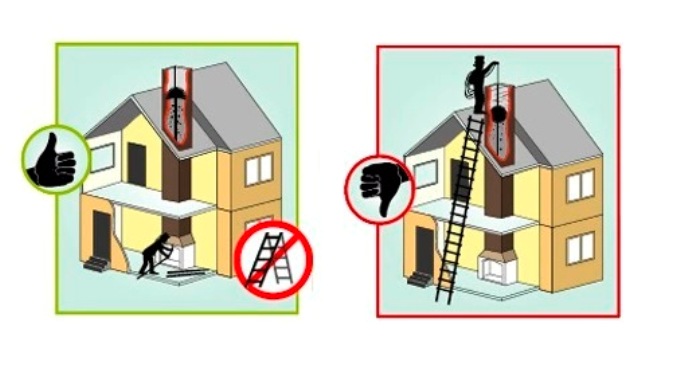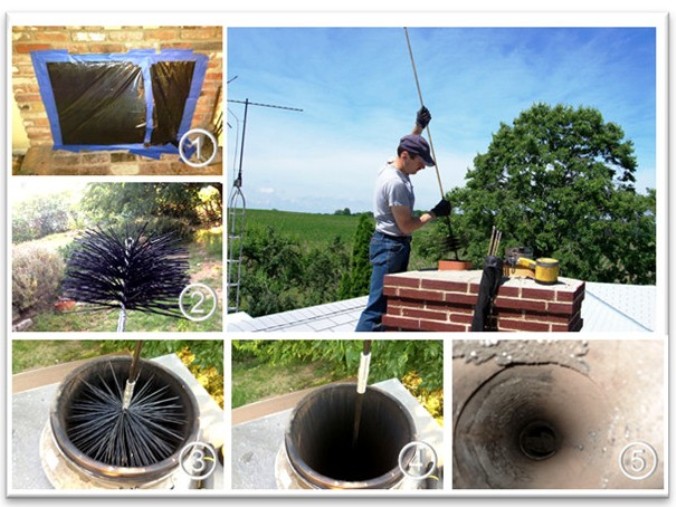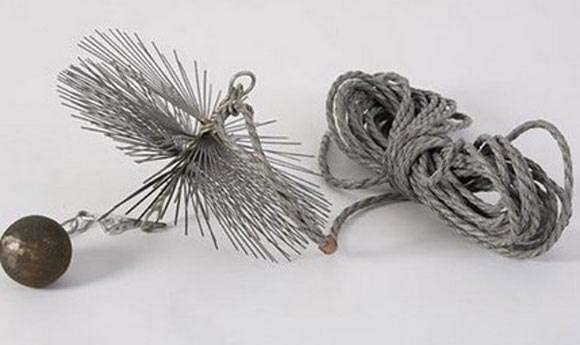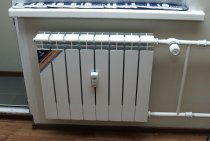What causes clogged chimneys
Chimney clogging occurs due to:
- the use of raw and/or tar firewood;
- insufficient draft in the chimney and furnace;
- burning in the furnace of garbage.
Chimney before and after cleaning
In the ideal case, the firewood in the furnace burns out completely, and only carbon dioxide, water vapor and a minimum amount of fine ash go into the chimney. But with incomplete combustion of wood, resins and large amounts of soot also enter the pipe. Moreover, together with the condensate, all this mixture settles on the walls of the chimney channel and gradually narrows it. It is these layers that have to be removed regularly by cleaning the chimney.
Chimney soot removal method 3
In this case, potato peelings are used. The method is based on the fact that potato starch will interact with soot on the walls of the chimney and simply split it. It is recommended to add half a bucket or a bucket of potato peels to a burning stove (depending on the size of the stove). Instead of peeling, you can add whole potatoes. This method is relevant if the quality of the potatoes does not suit you.
After burning potatoes, starch rises through the pipe, interacting with soot and deposits on the walls. In this case, the very structure of the soot changes. After a while, the deposits themselves will begin to fall off the walls. If it seems to you that the intensity of soot falling off is not high enough, then you can knock on the chimney tube with a stick.
Folk methods of contactless cleaning
Please note that contactless cleaning eliminates the problem only for a while. If you have difficulty with mechanical cleaning, use the services of professionals
It is not recommended to kindle a fire inside the chimney, as the flame can get from the firebox into the living room!
The people often use the following methods to combat soot and burning:
- Burning potato skins together with firewood;
- Placement in the pipe of a bag filled with bricks;
- Using pine wood to clean the chimney.
Please be aware that none of these methods is a reliable cleaning method and does not guarantee an adequate degree of safety. The best methods are mechanical or chemical cleaning. In some cases, you can combine several options, if your design allows it.
Why is the chimney clogged
Chimney clogging is a natural process that occurs as a result of combustion. Only part of the fuel, breaking up into fractions, acquires a gaseous form and goes out into the atmosphere as an emission.
Other fragments with a heavier, denser structure take the form of soot deposits and settle on the inner surface of the pipeline, over time significantly worsening its throughput.
The use of firewood from coniferous trees provokes clogging of channels. Viscous resinous substances, contained in excess in the composition, form a powerful adhesive base and help retain soot deposits on it.
Such contamination is difficult to prep clean and requires careful removal by means of mechanical devices.
Household garbage, packaging containers, remnants of old furniture, textiles and other items that are not a fuel resource by definition emit caustic ether complexes, heavy carcinogens and resinous compounds during combustion.
Therefore, burning in the furnace or fireplace of such human waste adversely affects the operation of heating equipment of any class.
All of them in the form of a dense, viscous sediment cover the inner surface of the pipes and create conditions for retaining soot, soot and soot.The channel through which the gaseous elements escape into the atmosphere narrows to a minimum, the draft overturns, and part of the smoke enters the living room.
The temperature in the room drops and the use of heating equipment becomes dangerous due to the risk of carbon monoxide poisoning.
They accelerate the clogging of the chimney channel with deposits of firewood from a recently sawn, damp forest.
If the current moisture content of a log exceeds 12%, it is strictly forbidden to throw it into the firebox immediately. It is necessary to dry it thoroughly in a warm room for at least 1 week.
A damp log reduces the level of heat transfer by 35%, contributes to the rapid clogging of the smoke exhaust system, and eventually disables it.
Sometimes an active accumulation of soot inside the pipe provokes mistakes that are accidentally or due to inexperience made in the process of laying the firebox and arranging the chimney for a fireplace or stove.
- incorrectly calculated angle of inclination of the pipe;
- too thin walls of the drainage system;
- improperly selected chimney pipe;
- increased volume of condensate formed due to insufficient thermal insulation;
- excessive number of bends and turns of the chimney path;
- roughness on the inner surface of the outlet channels.
It is these reasons that accelerate the pollution of chimneys and several times reduce the efficiency of stoves, boilers and fireplaces. Homeowners are advised to be very careful in choosing stove-makers and contact only those who have already confirmed their skills and high qualifications.
Otherwise, with enviable regularity, the question will arise of how to clean a home chimney, giving you a lot of trouble and requiring constant financial costs.
Chemistry for soot control
To reduce the need for chimney sweep services, you can use chemical agents to prevent the formation of soot - liquids, powders or briquettes that must be added to burning wood. All these tools contribute to the destruction of the soot layer and its shedding down the walls of the chimney.
The most popular means:
- PHC protivonagarny powder - is burned simultaneously with firewood, 150-120 g is enough for one ton of fuel;
- cleaner Kominichek - a product made in the Czech Republic and sold in the form of a package with five sachets weighing 14 g;
- chimney sweep log - has the shape of a bar, when burned, substances are released that clean out carbon deposits along with the flow of combustion products escaping through the chimney;
- Cheerful chimney sweep powder contains resins that lower the temperature and help burn out soot, it is not a toxic agent, which distinguishes it from competitors.
You can buy all of the above chemicals at any household supermarket.
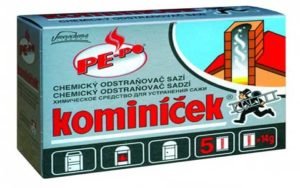
According to the instructions, one bag is enough to clean the stove or fireplace, two are required for a wood-burning heating boiler. The bag should be thrown onto the burning firewood without opening it, and the firebox door should be closed. The dose cannot be increased.
If the soot layer is very thick, it is better to repeat the procedure. For prevention purposes, it is advisable to burn one sachet every two weeks. In addition to removing soot, this tool increases the efficiency of wood-burning heaters and saves money when purchasing fuel.
The second most popular tool is the Chimney Sweep log - a bar (briquette), during the combustion of which substances are released that act on soot deposits and contribute to their shedding down. The main purpose of this chemical cleaner is to prevent narrowing of the chimney section due to soot and soot deposits.
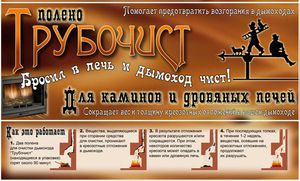
The "chimney sweep" consists of sawdust, coal wax with coal dust, ammonium sulfate, urea, zinc chloride, sodium sulfate, silica and phosphorus oxide. This tool is especially effective for brick chimneys.
Before using the Chimney Sweep for the first time, you must make sure that there are no loose bricks, debris, bottles or bird nests in the chimney. The most efficient burning of briquettes is on hot coals. Additives entering the pipe affect its inner surface for up to two weeks. All this time, soot falls into the furnace from above. After two weeks, it is advisable to clean the knee and the smoke damper.
Checking the quality of cleaning
The easiest way to check is to shine a flashlight into the chimney. If you do not find a gray, brown or black coating on its walls, then the cleaning was done with high quality. The absence of an unpleasant odor during the burning of firewood also indicates that no harmful substances remain in the chimney. During cleaning, foreign objects may enter the chimney (for example, a piece of rope, fibers from a brush and other consumables). Before lighting the firewood and the first check, carefully check that the chimney is free of foreign debris.
If you suspect that the chimney was damaged during cleaning, do not use it under any circumstances until a preliminary inspection. Perform a thorough check yourself or invite a specialist.
Remember - if the diagnosis or cleaning is done incorrectly, it is not recommended to use such a chimney in the near future.
Why does the stove smoke with a clean pipe
Smoke from the stove can also occur with a clean chimney, there may be several reasons. In addition to soot deposits in the chimney, smoke obstruction can cause:
- the absence of a windproof cap on the chimney - in this case, the fireplace or stove smokes with a strong wind;
- cracks in the masonry of the stove - in windy weather, air jams are created in the chimney, which redirect combustion products through the cracks into the room;
- a large amount of ash in the blower, which disrupts draft;
- burnt oven wall;
- insufficiently tightly closed doors that are designed to clean the oven;
- use of brushwood or straw as fuel;
- a gas outlet channel located below the furnace door;
- increased humidity in the chimney.
If there is too much moisture in the chimney, then you need to put thin sticks or dry alcohol into the cleaning window and set it on fire. At the same time, the stove should be flooded, and after the restoration of traction, close the window.
Do-it-yourself chimney cleaning from soot
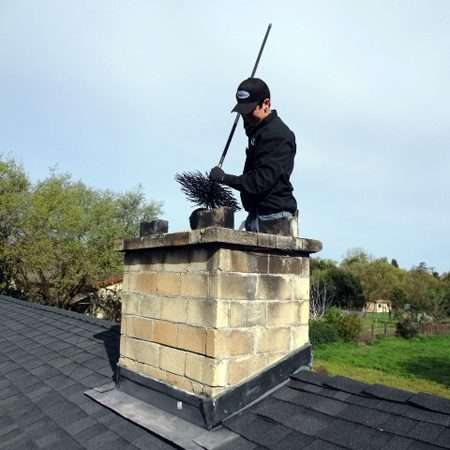
- If the oven has never been cleaned, be prepared that it may fail at any time.
- Dark streaks appeared under the valve or cleaning doors.
- There is a smell of soot or soot has come out on the outer wall of the furnace or pipe.
- Cracks have appeared on the stove, and smoke is coming out of them.
- The stove, fireplace or boiler began to smoke into the room.
- Black streaks appeared on the outside of the pipe head.
- The oven started to heat up worse than before.
Leave a request and our manager will contact you within 15 minutes To order the service, fill in the fields below
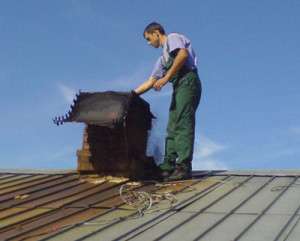
Therefore, do not bring your stoves, fireplaces or boilers to the extreme - arrange for the chimneys of your hearths to be cleaned at least once every two to three years. After all, cleaning chimneys is a very simple operation, accessible to literally any “home” master. And in Russian villages, where the stove is still the source of heat, this business is not even done by men, but by ordinary housewives. So cast aside doubts and immediately start cleaning the chimney. Well, we, in turn, will support you morally and teach you all the subtleties of this simple operation.
Safety
In the process of cleaning the pipe from the roof, you should always remember the safety measures:
- do not work on the roof in rainy or windy weather;
- be sure to use insurance;
- in the absence of a safety system, you can tie yourself around your belt with a strong rope;
- before work, it is forbidden to take any medicines that can reduce the reaction rate. It is strictly forbidden to drink alcohol.
How to clean the chimney, an example in the video:
Various animals can often live in the chimney pipe - birds like to build nests there, wasps build their combs, etc. If it is possible to get a nest, then it is better to remove it through the top of the pipe. If it is deep, then it is better to push it down.
Wasp nests should be handled with care. If a colony of wasps lives in it, then it is better to play it safe once again and put on a special beekeeper suit.
How to clean a chimney
If problems are identified, you can clean the chimneys yourself using both professional and folk methods. To do this, it is enough to use mechanical devices, special chemicals and just household salt or starch. But much here depends on the degree of clogging and the amount of soot inside. Often, with such a cleaning, you have to resort to several methods at once.
How to properly clean your chimney
Mechanical methods
The most effective way to clean the chimney is mechanical. Chimney sweeps have been using it for more than a century; the entire technology of this process has been worked out to the smallest detail during this time. It is possible to clean the chimney using this method both from the bottom of the stove (fireplace hearth) and from the top from the roof. But there are nuances.
From above, in this way it will be possible to clean only the vertical section of the chimney channel.
How to clean a chimney with a telescopic brush
The places where the pipe turns should be cleaned of soot from the inside of the house through the firebox or special doors (holes) in the stove masonry.
As a tool for mechanical cleaning is used:
- Ruff on a stick or rope with a sinker below.
- Ruff on a flexible cable (similar analogues are used by plumbers).
- Metal scraper for particularly stubborn soot stains.

How to clean the chimney from below

How to make a chimney brush from plastic bottles
Chemical methods
If you don’t want to try on the role of a chimney sweep on the roof, then you can use specialized chemistry. Now there are a lot of products based on copper chloride and ammonium sulfate with phosphorus oxide. At first glance, as well as choosing an air conditioner for an apartment, it is difficult to understand the range of such chemicals. But everything is quite simple - it is allowed to take any option.

How does a chemical chimney cleaner work?
These chemicals emit smoke when burned, which travels up the chimney and loosens the soot, causing it to fall down. Then it only needs to be collected with a scoop from the bends of the chimney and the stove or fireplace.
Similar chemistry is produced in the form of powders in bags and briquette logs. The main nuance of their use is the need for thorough ventilation of the housing during cleaning and immediately after.

Chimney cleaners
Cleaning the chimney with these products is as easy as shelling pears, threw them into the firebox and that's it. However, when burned, they emit unpleasant and harmful components, which are definitely not worth breathing.
Folk ways to clean the chimney
You can also clean the chimneys of fireplaces, gas boilers and coal-wood stoves using:
- table salt (half a kilo for kindling);
- dry potato peelings and simply chopped potatoes (a few kilograms at a time);
- powdered naphthalene (apply to logs, emits a pungent odor);
- aspen wood.
The principle of operation here is simple - vapors of sodium chloride (salt), starch (from potatoes) and naphthalene corrode the soot, carrying it along with the smoke up to the street or forcing it to fall down. With dry aspen, the situation is somewhat different, this wood burns with the highest temperature among all other types of firewood. Dust soot on the walls of the chimney from this heat simply burns out.
Brush with load
Chimney cleaning with the help of various mechanical devices has been known for a long time. It was this method that was imprinted in the folklore of many European countries. Monuments to chimney sweeps can be found not only in the west, but even in Russia
Which once again speaks of the importance of their work. However, we will not be distracted from the main goal, namely, from answering the question of how to clean the chimney.
For round pipes, a ruff is best. This is a disc-shaped metal brush that is hung from a cable or rope. From below, a load is attached to the brush - a core or a spherical weight. Other items can also be used as cargo.
But here it is important to remember that only objects with a stable and undisplaced center of gravity should be used. Otherwise, such a load may get stuck in the pipe, and then the problem can only be solved by completely disassembling the chimney.
Under the action of gravity, the brush moves down the pipe. A rope is used for lifting. The core itself (without brush) can be used to break through tight blockages and plugs. Thanks to carabiner connections, brush elements can be quickly separated and assembled in the desired sequence.
Devices and rules for cleaning
The stove flue (chimney) pipe is cleaned if the layer of soot and soot reaches a thickness of 2 mm. Sequence of work:
- before mechanical cleaning, it is necessary to close all openings intended for cleaning in the house, the open fireplace must be curtained with a damp cloth;
- cleaning can only be carried out if there is no wind or rain outside;
- during cleaning at a height, it is imperative to use insurance;
- the fireplace is first cleaned from the inside (garbage is removed);
- before cleaning with a brush or brush, the debris is pushed down with a stick.
Basic fixtures:
- for a pipe with a circular cross section - a metal ruff with a diameter that is 20% larger than the size of the pipe;
- for a pipe with a square section - a brush with metal bristles;
- scraper;
- for punching blockages - a metal core.
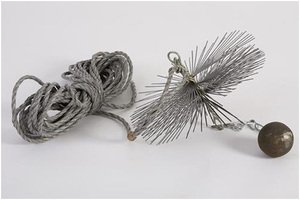
If the house has an open fireplace connected to a straight pipe, it is quite possible to clean it with a long-handled brush directly from the firebox. After cleaning the pipe, it is also necessary to clean all the windows for cleaning, blowing, the door and the firebox itself.
